@
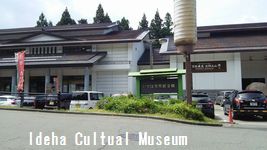
|
¡ Dewasanzan and Shugendo
Dewa Sanzan is a name applied to a group of three mountains: Mt. Gassan is called the mountain of the past, Mt. Haguro, the mountain of the present, and Mt. Yudono, the mountain of the future. When we go and worship around the three mountains, we travel symbolically through the whole world, and through the present, past and future, all the while maintaining our existence. By performing this cycle through the three mountains, one can be born again and live anew as a human being after death. Prince Hachiko, the first-born son of the then reigning Emperor Sushun, first opened the Dewa Sanzan as a religious center 1400 years ago in AD 593. After Prince Hachiko went through difficult and severe ascetic exercises in the Dewa Sanzan, he established Haguro Shugendo Asceticism. Dewa Sanzan today serves to carry on the spirit and tradition of Prince Hachiko's asceticism. |
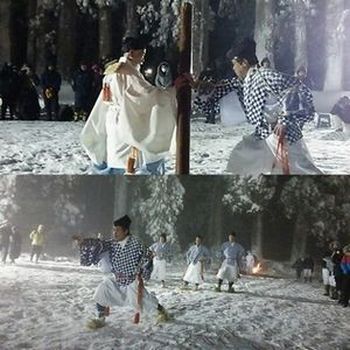
|
¡ mountai Worship in Japan
Natural phenomena were the object of worship in ancient times. Mountain worship injects nature worship with religious significance through the performance of rituals. Shugendo is a fusion of Mountain worship and Esoteric Buddhism. There were many sacred mountains connected with Shugendo all over Japan. "Kuni Wake Shinji," the ritual dividing of counties, is held during the Shoureisai, the Fire Festival. According to the chronicles of this historical event, the deity of Haguro determined that the eastern 33 counties in the surrounding 66 Japanese counties were to be Mt. Haguro's territories, and the western 24 as Mt. Kumano's territories. The remaining 9 counties in Kyushu were designated as Mt. Hikosan's territories. |
@
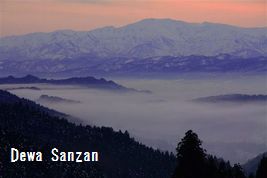
|
¡ Dewa Saanzan and Mandala
Mandala means gcircle,h encompassing an assembly of divinities, and is indicated by a graphic representation of the stages within the realm of enlightenment. It also indicates the location of the divinitiesf activities, and is used particularly in esoteric Buddhism. In Haguro Shugendo, Mt. Haguro is worshiped as the Kannon Buddha's Jodo Mandala, (Jodo means pure land that fully utilizes the power and effects of esoteric Buddhism in this world). Mt. Gassan is worshipped as Amida Buddha's Jodo Mandala, and Mt. Yudono as Dainichi Buddha's Jodo Mandala. The approach to Mt. Gassan from Mt. Haguro is enshrined the thirteenth Mandalas. The east side of the approach to Mt. Gassan, which includes Mt. Hiuchidake and Mt. Kokuzodake is recognized as Kongokai Mandala (Kongokai means the indestructible world ; its characteristic is that the same buddhas can appear as often as they please, changing shape and form ,which represents 'wisdom'). The west side of it includes Mt. Yudono. Mt. Shinakura is recognized as Taizoukai Mandala. (Taizokai means the world of unity with Buddha, where all creatures are seen as being nurtured and cared for in the 'womb' of Buddha. It is symbolic of believers departing from the east to find enlightenment, through the process of performing ascetic acts, and represents the truth or reason of the physical world.) And the practitioners of Shugendo worship rocks, ravines, ponds and marshes in the mountains as other incarnations of Buddha and local deities. |
|
¡ Fall Peak
Akino-Mine, Fall Peak, is so called because it is "the peak of the advancement in life for Yamabushi,h for Yambushi who have their family at the foot of the mountains and for other group, Sato- Yamabushi scattered throughout various countries. Yamabushi Asceticism is composed of the Jikkai, ten ascetic Buddhist acts or "worlds." The Jikkai begin with the six ways of delusion (Rokubon), then that of hell (Jigoku-kai) as represented by inhaling acrid smoke (Numban-Ibushi), that of hungry ghosts (Gaki-Kai) as represented by fasting (Danjiki), that of beasts (Chikusho-Kai) as represented by abstaining from water (Mizudachi), that of devils (Shura-Kai) as represented by wrestling (Tengu Sumo), that of humans (Ningen-Kai) as represented by repentance (Zange), and that of heaven (Tenjo-Kai) as represented by the dance of long life (Naruko). Following are the four ways of enlightenment (Shisei): that of disciples (Shomon-Kai) as represented by listening to the sounds of nature on Mt. Gassan (Kogi); that of the self-enlightened Buddhas (Engaku-Kai) as represented by transferring water from one tub to another (Aka); that of saints (Bosatsu-Kai) as represented by the act of teaching what one has learned to those who still are going through the six ways of delusion (Tokogatame); and finally that of becoming a living Buddha (Jobutsu) which is verified by the head of the Haguro Sect of Asceticism, the "Dai-Sendatsu.h Before beginning their journey through the ten ascetic worlds, the Yamabushi hold a funeral service for themselves. This represents their gdeathh prior to the process of rebirth. It is symbolically significant that their souls are conceived in the mother's womb again by "Bonten-Toji,h a ritual of throwing Bonten (a long pole with paper streamers) and they day by day grow up from a new birth. |
@
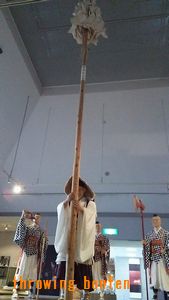
|
¡ Throwing Bonten
At the front of the temple, the Daisendatsu (the great leader of the Yamabushi) who carried "Oi" (the portable alter) on his back and wore "Ayaigasa" (the straw hat) on his head, falls on his knees and performs with the Bonten (a long pole with paper streamers), first giving it three turns to the left side, and then three turns to the right side. He then cries out in a loud voice a magical spell,"Ah Un" and throws the Bonten into the temple. It signifies that the conception and birth of a new life has occurred at this moment. Then the sounds of congratulation blown through a "Horagai" (a conch shell) resound throughout the mountains. After "Matsunoreih (a ceremony that serves as a formal pronouncement that Fall peak has begun) is held, "Oi and Ayaigasa" are transferred to the Doshi (one of the five leaders of the Yamabushi who hands down all directions and instructions to the participants) from the Daisendatsu. Bonten: The word comes from the Sanskrit for "Brahma.h During the Fall Peak of Haguro Shugendo, it represents the heavens in stillness and purity far from this world of delusions and it is also a symbol of the male phallus that contrasts with the temple that serves as a symbol of the female's genitals. Oi: It is the symbol of the womb of the mother in which one is conceived and reborn during the ascetic confinement within the mountains. The red strings on the Oi represent blood vessels. Ayaigsa: It serves as a symbol of the mother's placenta sheltering the fetus in the womb. |
@
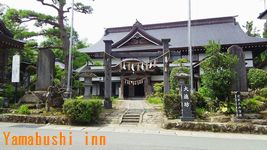
|
¡ Organization and Role
Haguro Shugen, Haguro Asceticism, is a combination of gSeiso Shugenh (the way of a Buddhist priest who remains unmarried and a vegetarian throughout his life. The Seiso Shugen lives on the mountain) and of gSaitai Shugenh (the way of a married Yamabushi with a family and who would pass on his post as Yamabushi to his son. He lives at the foot of the mountain, runs a yamabushi inn and performs the fire rite). Group members of the Saitai Shugen were composed gOnbunh (well-born people who served as responsible officers under the chief retainer of the chief temple and who were appointed to administer the affairs of the village) and of gHiramonjinh (members of the community who had day jobs in farming, commerce and industry and lived in the temple town.) Other members of the Hiramonjin were people hired by the Seiso Shugen and Onbun to serve as guides in the mountains, to help perform rituals, do housekeeping chores and help make charms. They were considered employees and were never nominated to high office in the priestsf lodge or in public affairs. |
|
¡ @Kasumi, Onshi and Zaicho Kasumi-ba, sometimes called simply Kasumi, refers to the parish of control belonging to Shugendo, the practice of Shugen. Control of the Kasumi fell to the Onshi, Zaicho and Onshizaicho. Zaicho: These people possessed the exclusive right to issue the charms of the mountain deities and who were responsible for lodging the pilgrims of the parish. They were also agents responsible for promoting the Sato-Yamabushi (Yamabushi who lived off the mountains) to a higher rank, but they did not possess the right to grant them diplomas of which the rank in Haguro Shugendo were corresponded to two periods of the entry into the Akino Mine. Onshi: These people were local leaders and guides in the parish who possessed the exclusive right of guiding pilgrims in the mountains. They also delivered to the pilgrims the charms of the three mountainsf deities produced by the Zaicho. Onshizaicho: They possessed the exclusive rights of both the Zaicho and Onshi. |
@
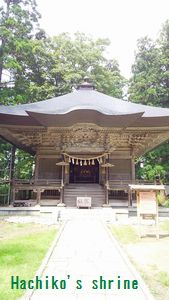
|
¡ The History of the Dewa Sanzan The Dewa Sanzan has a long history. It was first opened as a religious center 1400 years ago by Prince Hachiko. After its founding, many temples and quarters for priests, including the main shrine on Mt. Haguro-san, were built by practitioners of Shugendo. In the last years of the Heian Era , the Dewa Sanzan formed the largest training center for Shugendo and welcomed practitioners from many nations. By the Kamakura Era (AD 794-1192), there were many active exchanges between the Dewa Sanzanfs practitioners and those from other nations. But during the Warring States Period , the religious practices and exchanges of the Dewa Sanzan fell into disorder due to the unstable political situation. As a result, the power and influence of the Dewa Sanzan fell into decline. Tenyu-Betto, chief priest of the Dewa Sanzan shrine in the Edo Era (1630), brought about a restoration and succeeded in rebuilding the power of the Dewa Sanzan. After the Meiji Restoration (1868), Shinto and Buddhism were separated by order of the Japanese government. Thus, the Dewa Sanzan became a sacred place based on Shinto. |
@
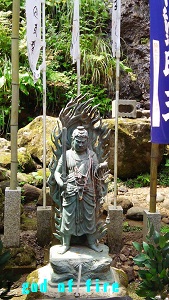
|
¡The God of Fire All practitioners of Shugendo and all yamabushi in Japan dedicated themselves to gFudomoyo,h the God of Fire. Traditionally, the God of Fire carries a sword in his right hand to punish all the wicked and a rope in his left hand to scoop up all supplicants to his strong sense of justice and mercy. Practitioners of Shugendo were considered able to become the God of Fire. According to the history of Mt. Haguro-san, at Arasawa , Fudomoyo initiated the founder of the Dewa Sanzan, Prince Hachiko, into the secret of the fire rite. Fudomoyo cut the tip of his own elbow with his sword and let the dripping blood fall on firewood. The wood suddenly burst into flames. This fire was then revered and worshipped as gHijikiri-Fudosonh by Prince Hachiko and it became the fundamental and perpetual fire of Haguro Shugendo. |
@
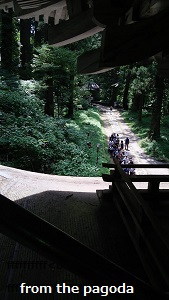
|
¡ The Section of the Dewa Sanzanfs Cultural Heritage and Entertainment The Dewa Sanzanfs long history and tradition includes many cultural artifacts among its heritage. There are many wooden printing blocks carved by unknown Yamabushi. There are other items designated as Tangible Cultural Properties and national treasures by the Japanese government, such as the Five-Story Pagoda at the foot of Mt. Haguro. There are other intangible cultural assets and beliefs connected with Haguro Shugendo, such as Shinto rites and festivals that have been handed down from generation to generation among the villagers at the foot of the mountains. |
|
¡The Dewa Sanzanfs Cultural Heritage Much of the heritage we enjoy from the Dewa Sanzan comes to us from the time of the fusion of Shinto and Buddhism. Traces of this fusion can be seen today, such as in the Five Story Pagoda which is one of the Northeastfs most magnificent buildings. Traditionally, it is said that Taira no Masakado, a military commander during the years 971-937, built this pagoda. The Kenji no Taisho, the Great Bell of the Kamakura Era at the precincts of the shrine on Mt. Haguro and inscribed with date 1275, is said to have been donated by the Kamakura Shogun who was grateful for having repulsed the Mongol fleet of invaders the year before. The Haguro-Kyo, the Mirrors of Haguro, were unearthed in the Mirror Pond in front of the Sanjin Gosaiden. The Sanjin Gosaiden is the main shrine building on Mt. Haguro-san. This building dates from the Edo Era (1603-1867) when the Dewa Sanzan was at the height of its power. The Sanjin Gosaiden joins together the three mountainsf deities. The Saikan used to be a temple called Kozoin and now serves as a facility providing visitors to the Dewa Sanzan with accommodations and meals. In the Minami Dani, the Southern Valley, the vestiges of cornerstones and the pond remind us of the templefs former prosperity. The front approach to the main shrine, made of stone steps bordered by a row of aged cedar trees, was also constructed during this time. |
@
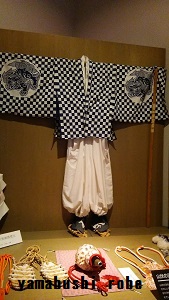
|
¡@The Yamabushi Robe and Accouterments The Yamabushifs robe and its attachments each have doctrinal significance. They also have a practical use during the Yamabushifs training in the mountains. It is said that by wearing this robe and its accoutrements the practitioner of Shugendo becomes unified with Dainichi Buddha and Fudomyo. |
@
|
¡Entertainments at the Dewa Sanzen There has been a desire for entertainment in the cultural blood of Shugendo. These entertainments have been handed down as religious rites and festivals among the villagers of the Dewa Sanzan. It is said that the gEnnen no Mai,h the Dance for Longevity, has been performed in the gJikkai,h the ten Buddhist ascetic worlds of the Akino Mine. Even today we can see entertainments that originated at the Dewa Sanzen held throughout the Shonai District. Some examples are the gTakadera Hakkoh in Haguro, the Niiyama Ennenh in Hirata, the Kurokawa Noh Play in Kushibiki and the g Shishi Mai,h a lion dance, across the country. All of these have religious significance associated with the Dewa Sanzen. |
@
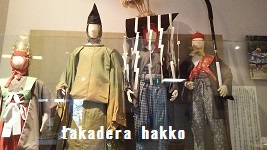
|
¡Takadera Hakko @ It is said that the Raiden Shrine in Takadera, is dedicated to the Lightening Deity, the Great Rock on Mt. Gassan, an object of worship in a Shinto Shrine. gHakkoh is named after eight groups of players. Daysho, Naginata, Hanagasa and Chigo dances are performed here. |
@
|
¡The Importance of the Dewa Sanzen The Dewa Sanzen has been worshipped for a long time as the place where the souls of our ancestors dwelt after death. The mountains also provide the people with water to grow rich, with firewood and with edible wild plants throughout the year. @@@@ The mountains are not only respected for the life they give us, but also are revered as the place where the deities reside. |
@
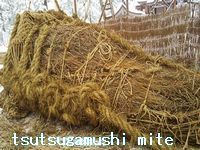
|
¡The Tsutsugamushi Mite in the Shoureisai Festival @ Among the annual events of the Yamabushi, the most dynamic one is the Fire Festival, held in the severe winter from December 31st to January 1st. It is called the Fire Festival because all the defilement of the last year is incinerated and the impure fire is transformed into a newly pure and strong fire. Approximately 1400 years ago, Prince Hachiko, founder of the Dewa Sanzen, guided the local people and instructed them to grow five crops. Thanks to his guidance, the people of the area lived peacefully with the rich and fertile soil and bountiful harvests. But one year, many villagers suffered and died from an evil: the Tsutsugamushi mite. When Prince Hachiko saw the devastation he prayed for 100 days. In response to his devotions, the Deity ordered him to burn out this evil that was causing the people to suffer. He immediately got down to work and burned out the mite much to peoplefs benefit. Since then, we have held the Fire Festival to honor and thank the Great Deity for his favor and to show thanks to the Princefs mercy. During the Fire Festival, a big torch in the shape of the mite is cut to pieces. Then it is put back together again, the tsutsugamushi mite is brought back to life. Finally young people burn it. The quality of the fire is believed to portend the quality and quantity of next yearfs harvest. |
@
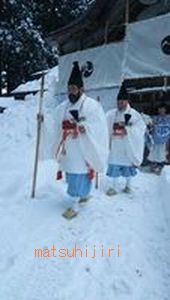
|
¡@Shugendo and an Agricultural Ritual There are four ritual periods of Haguro Shugendo, each of which is designated as a seasonal gpeak.h All are connected with agricultural practices. The first ritual period begins at the New Year celebrations and is connected to the rite of the Deity falling from the mountain to the rice fields. From spring until autumn, the Deity resides in the fields. After the harvest, a rite is held to return the Deity to the mountain. In the Shourei Festival, two gMatsuhijirih (who are main figures during the winter peak, Fuyu no Mine) play an important role because they annually hold Kojinsai, literally the Festival of Divine Descent and then engage in one hundred days of ritual purification. gHijirih literally means a person who knows the movement of the sun. gMatsuhijirih literally means the hijiri who are waiting for the gflash of lightning.h Our ancient people believed that lightning makes the gSpirit of the Riceh pregnant and nurses the flowering of the rice plant. The prayers of the Matsuhijiri are answered after one hundred days and bring the Spirit of the Rice and other crops into existence. The Shoureisai Festival is held on the last day of the one hundred day prayer cycle. Yamabushi, practitioners of Shugendo, conduct all these rituals. |
@
|
¡Making a Pilgrimage to The Dewa Sanzen In the summer, a large number of laymen make a pilgrimage to the Dewa Sanzen. They who have gone through the hard trip living on a vegetarian diet for several days arrive at the foot of Mt. Haguro and then settle into their designated Yamabushi inn. That night they perform purification rite. The next morning they go and worship at the three mountains guided by the Sendatsu. They pray to the deities for the safety of their villagefs families, for the fertility of the grain crops and for the souls of their dead ancestors. There is a guide book for the pilgrims of the Dewa Sanzen, San Zan Gashu, published in 1710, and an illustrated guide book produced from 1818-1830. |
@
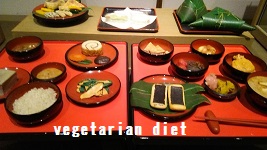
|
¡@Meals at the Yamabushi Inn @ The day before the pilgrims go up Mt. Gassan to worship they are served with vegetarian cuisine, the food of which comes from the Yamabushifs self-sufficient life style. A reproduction of the meal served by the Yamabushi Inn is displayed here. The reproduction is also that which was served to upper class laymen who lived in the Kanto district. |
@


¡@Dishes in the hut @ Each stage in the climb to the top of Mt. Gassan had a mountain hut for climbers. Every hut had its own noted dishes such as a rice cake covered with bean jam and thin wheat noodles. Mt. Gassan was so crowded with pilgrims that to prevent untoward competition between the mountain huts to acquire pilgrims the specialty dish of each hut was prepared by the Betto, the chief priest who manages the business of Dewa Sanzan. |
@

|
¡@The Dress of the Pilgrims Going around the three mountains, the pilgrims travel symbolically through the whole world: present, past and future, all the while maintaining their existence. This idea comes from the cycle of life in Buddhism where everyone wishes for rebirth as a human being after death. That's why the pilgrims dress in white and hang the "Shimekake," the sacred straw festoon over their necks. This represents the figure of the dead and the elimination of an impure body. Thus, after going through the three mountains, the pilgrims have been born again and come back to this world with purified bodies and strong spirits. |
@
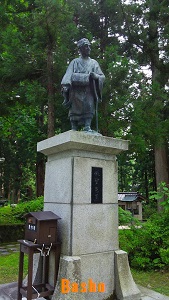
|
¡@
The Section of " The narrow road of the deep north" and Dewa Sanzan Traveling on "The narrow road of the deep north" "The narrow road of the deep north" written by Matsuo Basho in 1694 is a travel diary interspersed with haiku (17 syllable poems). Basho, the great haiku master, lived from 1644-94. For inspiration Basho journeyed throughout the country, in search of communion with nature and relics of previous days. From March to September of 1689, he underwent a pilgrimage from his hermitage at Fukagawa in Edo to the northern provinces with a disciple, Kawai Sora. Their journey lasted 160 days and terminated at Ogaki in present day Gifu Prefecture. I t was the longest journey he had ever undertaken, and he composed some his finest haiku at this time. During their journey, they traced the places where Saigyo and Noin, Tanka poets in the Heian Era (794-1192) and Kamakura Era (1192-1333), had visited. They were fascinated with the scenic beauty of Matsushima, Kisakata and various other places along the way. It is said that Bashofs motive to undertake this journey might have been to attain "the World of Death and Rebirth,h and perhaps therefore, Bashofs visit to the Dewa Sanzan for 8 days was his primary destination. Nowadays "The narrow road of the deep north" is an internationally renowned literary work and stands as one of the finest examples of Japanese literature. |
@
|
¡ "The narrow road of the deep north" in the Dewa Sanzan The Dewa Sanzan has prospered as sacred mountains. The area of "Toge,h which lies in the front of Mt. Haguro, especially prospered because it has been one of the seven starting points of a trail up the three mountains, and has always been crowded with pilgrims. On June of 1689, Matsuo Basho arrived at Toge and spent his stay here while worshipping at the three mountains. It is said that while traveling there, he was awakened spiritually to the theory of the gFueki-Ryuko,h which goes like this. By contemplating phenomena in nature that change with the seasons, one penetrates their underlying eternity, perceiving them as unchangeable, and concludes with the idea that the changes blend together into one. Thus the Dewa Sanza has become the most commemorative and celebrated place in Bashofs journey on gThe narrow road of the deep north.h |
@
|
¡The Minamidani at the Time of Bashofs Visit In the Minamidani, the southern valley, there used to be the temple where Basho once stayed. Sonchoin Keikai, who was then the Betto, the chief priest of the Dewa Sanzan, built this temple. Here there were three garden ponds surrounding the temple and these ponds were irrigated from the nearby Fukikoshi River. The stone bridges that crossed from the small islands in the ponds had an exquisite curve and many cherry trees were planted around the ponds. |
@
|
¡ A Haiku Poet: Romaru of Haguro Romaru is the pen name of Zushi Sakichi, a haiku poet who lived in Kamei-cho, Toge at the back of Okawa Senuemon's residence and who ran a dye house. During Basho's stay in Haguro, he took good care of the great haiku master and tried to learn the essence of the elegant and tasteful style of Bashofs poetry. Romaru collected some of his learnings from Basho and published them in book form, which is titled the "Kikigaki no Nanokagusa". In the autumn of 1692, Romaru dropped in at Basho's hermitage on his way to Kyoto where Basho presented him with his "Mikazuki-nikki,h a diary of a crescent moon, an unfinished collection of haiku written by Basho. Romaru asked someone going to his home in Haguro to bring it there and then he went on to Kyoto. In September, he called on Kyorai, one of Basho's disciples with Basho's letter of introduction. But it is said that Romaru died in Kyoto next year, on February 2nd, and never returned to his home. |
@
|
¡ Basho and Haiku in Shonai Before Basho visited Shonai, the haiku poets here belonged to the conservative group in the style of haiku. But after meeting Basho, many poets became disciples of Basho, including Romaro. Since then Haguro and Shonai have been frequented by the disciples of Basho. During the time of the Kyoho Period(1716-36), Koshichi and Fuuso, both called on Shiko, Basho's disciple in Mino, in present day Gifu Prefecture. In Shonai, because of Bashofs influence, the gMinoh style of haiku became the mainstream faction and endured until the last days of the Tokugawa Shogunate, the style remained popular for nine generations. With this background, the people in the area around Mt. Haguro have compiled many collections of haiku, entitled gHaguro,h gMinamidani-shu,h and gSanzan-Gashu.h |
@
|
¡ International Haiku Haiku, born of contemplating phenomena in nature and from the changing seasons of Japan, may be the most compact verse form in the world. Recently haiku has spread throughout the world through translations and is now composed not only in the western countries of North America, and in Europe, especially England, but also in other Asian countries, such as China. The body of work in haiku is steadily increasing in the world, although styles may differ from the traditional Japanese haiku. Some haiku exhibit a stronger sensitivity than that of Japanese. The haiku of the Dewa Sanzan has become better known internationally as more people from other countries have visited here. |